Welcome to the website for landscape facilities products and knowledge.
How does the bin’s construction minimize the risk of insect infestations?
Modern waste bins are engineered to significantly reduce the risk of insect infestations through multiple innovative design features. High-quality bins incorporate tight-sealing lids that create physical barriers against flies, ants, and other pests. Many models use smooth, non-porous materials like stainless steel or special plastics that eliminate crevices where insects might hide or lay eggs.
Advanced designs often include odor-control mechanisms such as carbon filters or antimicrobial coatings that neutralize smells attractive to pests. Some feature foot pedals or touchless opening systems to minimize contact and prevent residue buildup. The best insect-resistant bins have rounded interiors without corners where food particles might accumulate.
Proper construction also considers drainage to prevent liquid accumulation - a major attractant for insects. Many commercial-grade bins include removable inner buckets for easy cleaning, while residential models may have self-cleaning functions. The weight and stability of well-designed bins prevent tipping that could scatter waste and invite pests.
By combining these elements - from material selection to mechanical design - modern bins create an environment that's inherently hostile to insect colonization while maintaining user convenience and hygiene standards. This multi-layered approach addresses both prevention and containment of potential pest problems.
Related search:

Recommendation
Outdoor Metal Table - Classic Outdoor Furniture, Stainless Steel Table, Durable and Reliable